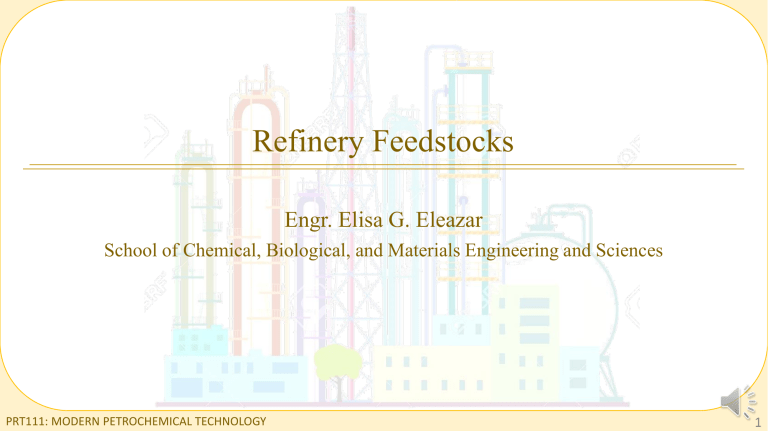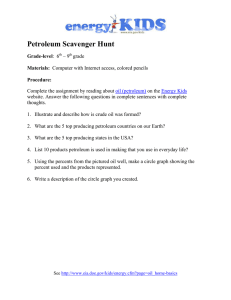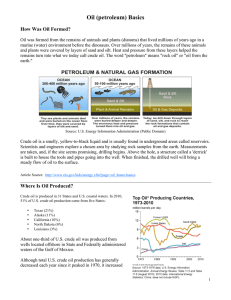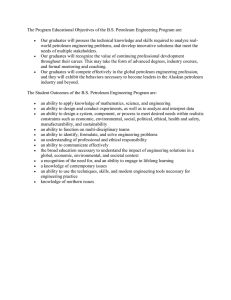
Refinery Feedstocks Engr. Elisa G. Eleazar School of Chemical, Biological, and Materials Engineering and Sciences PRT111: MODERN PETROCHEMICAL TECHNOLOGY 1 Outline Module 1.2: REFINERY FEEDSTOCKS Origin of Petroleum Occurrence of Petroleum Composition of Crude Petroleum Oil Properties of Crude Petroleum Oil PRT111: MODERN PETROCHEMICAL TECHNOLOGY Learning Outcomes 1. Explain and differentiate the theories on the origin of petroleum 2. Explain the occurrence of petroleum 3. Identify and differentiate the components of crude petroleum oil 4. Identify and explain the importance of the properties of crude petroleum oil 2 Origin of Petroleum Ancient Greek Explanation Greek Scientist Strabo 2000 years ago “At the place named Nymphey, there is a rock spitting fire, and under it are the sources of warm water and asphalts.” Organic Origin M.V. Lomonosov 18th century Russian Scientist “It is expelled from underground with heat, prepared from stone coal and brown coal, this black oily material.. And this is a birth of a different grade of combustible liquid and dry hard matter. This is the essence of stone oil, liquid pitch, petroleum and similar materials which are different by cleanliness, but occur from the same origin.” PRT111: MODERN PETROCHEMICAL TECHNOLOGY 3 Origin of Petroleum From the Great Flood a Warsaw Priest 18th century “The Earth was very fertile in the paradise period. The core of the earth contained a fatty impurity. After the paradise period, this fat was partially evaporated and the vapor partially condensed on the ground where it mixed up with a variety of materials. This was later transformed to petroleum by the world flood.” Inorganic Origin Berthelot 1866 “Large quantities of acetylene were assumed to be produced by the reaction of water with carbides, which, themselves, were formed by the reaction of alkali metals with carbonates. The conversion of acetylene to petroleum was accomplished at an elevated temperature and pressure. 𝐶𝑎𝐶𝑂3 → 𝐶𝑎𝐶2 + 𝐻2 𝑂 → 𝐶2 𝐻2 ↑𝑡𝑒𝑚𝑝 ↑𝑃 𝑝𝑒𝑡𝑟𝑜𝑙𝑒𝑢𝑚 PRT111: MODERN PETROCHEMICAL TECHNOLOGY 4 Origin of Petroleum Organic Origin 1. Marine organisms, together with sand, silt and other sediments, formed the rocks under the sea beds. 2. The layers of rocks contained the organic matter of the marine organisms. 3. Under the combined effects of the absence of oxygen, high pressure and temperature, catalysis and time, the chemical components of the marine organisms broke down and were transformed to hydrocarbon compounds trapped in small pores in the rocks, forming crude oil and natural gas within the rocks. 4. The oil and gas migrated through the permeable porous rocks in an upward direction. 5. The petroleum becomes trapped under an impermeable layer. PRT111: MODERN PETROCHEMICAL TECHNOLOGY 5 Occurrence of Petroleum Petroleum a mixture of gaseous, liquid, and solid hydrocarbon compounds that occur in sedimentary rock deposits throughout the world and also contains small quantities of nitrogen-, oxygen-, and sulfurcontaining compounds as well as trace amounts of metallic constituents. (Bestougeff, 1967; Colombo, 1967; Thornton, 1977; Speight, 1990) a naturally-occurring mixture of hydrocarbons, generally in a liquid state, which may also include compounds of sulfur, nitrogen, oxygen, metals and other elements. (ASTM, 2005b) • any naturally occurring hydrocarbon, whether in a liquid, gaseous, or solid state • any naturally occurring mixture of hydrocarbons, whether in a liquid, gaseous, or solid state • any naturally occurring mixture of one or more hydrocarbons, whether in a liquid, gaseous, or solid state and one or more of the following, that is to say, hydrogen sulfide, helium, and carbon dioxide PRT111: MODERN PETROCHEMICAL TECHNOLOGY 6 Occurrence of Petroleum Classes of Petroleum and Related Materials • materials that are of natural origin • materials that are manufactured • materials that are integral fractions derived from natural or manufactured products Natural Materials Derived Materials Manufactured Materials Petroleum Saturates Synthetic crude oil Natural gas Aromatics Distillates Heavy oil Resins Lubricating oils Bitumen Asphaltenes Wax Asphaltite Carbenes Residuum Asphaltoid Carboids Asphalt Ozocerite Coke Kerogen Tar Coal Pitch PRT111: MODERN PETROCHEMICAL TECHNOLOGY 7 Occurrence of Petroleum Petroleum • occurs in a reservoir that allows the crude material to be recovered by pumping operations as a free-flowing dark to light-colored liquid Heavy Oil • have much higher viscosity and lower API gravity • requires thermal stimulation of the reservoir for primary recovery • darker in color Bitumen • also called native asphalt or extra heavy oil • reddish brown to black materials of semisolid, viscous to brittle character • frequently found filling the pores and crevices of sandstone, limestone, argillaceous sediments • recovery is achieved by prior application of fracturing techniques Natural Gas • gases associated with petroliferous geologic formations • generally contains high proportions of methane, some alkanes and nonflammable gases (carbon dioxide, hydrogen sulfide, nitrogen, helium) PRT111: MODERN PETROCHEMICAL TECHNOLOGY 8 Occurrence of Petroleum Reserve • fraction of a commodity that can be recovered economically PRT111: MODERN PETROCHEMICAL TECHNOLOGY 9 Composition of Crude Petroleum Oil Elemental Analysis PRT111: MODERN PETROCHEMICAL TECHNOLOGY 10 Composition of Crude Petroleum Oil HYDROCARBONS PARAFFINS ISOPARAFFINS OLEFINS • saturated compounds • branched alkanes • alkenes • unbranched, straight chain molecules • have boiling points lower than n- • unsaturated hydrocarbons with at • rather unreactive and do not combine readily with other substances C1 to C4: gaseous C5 to C19: liquid paraffins least one double bond • more reactive than normal paraffins • desirable in motor spirit C20 up: solid PRT111: MODERN PETROCHEMICAL TECHNOLOGY 11 Composition of Crude Petroleum Oil HYDROCARBONS • cyclic saturated hydrocarbons • relatively inactive • desirable compounds for the production of good quality lube oil base stocks NAPHTHENES • unsaturated cyclic compounds composed of one or more benzene rings AROMATICS PRT111: MODERN PETROCHEMICAL TECHNOLOGY 12 Composition of Crude Petroleum Oil SULFUR COMPOUNDS • may cause problems in certain catalytic processes • promotes corrosion • causes pollution problems Sweet Crude: less than 1%w S Sour Crude: greater than 1%w S Forms of Sulfur in Crude Oil: Organic Sulfur Compounds Carbonyl sulfide Elemental Sulfur Dissolved Hydrogen sulfide PRT111: MODERN PETROCHEMICAL TECHNOLOGY 13 Composition of Crude Petroleum Oil SULFUR COMPOUNDS Mercaptans (Thiols) • 𝑅 − 𝑆𝐻 Thiopenes • polynuclear aromatic compounds • normally present in heavier fractions Sulfides / Disulfides • 𝑅 − 𝑆 − 𝑅′ • 𝑅 − 𝑆 − 𝑆 − 𝑅′ • often present in light fractions PRT111: MODERN PETROCHEMICAL TECHNOLOGY 14 Composition of Crude Petroleum Oil NITROGEN COMPOUNDS • • • • usually found in the heavier parts of the crude oil responsible for color and color instability and poisoning of certain catalysts produce atmospheric pollutants eliminated from the heavier parts of petroleum by severe cracking or hydrogenation PRT111: MODERN PETROCHEMICAL TECHNOLOGY 15 Composition of Crude Petroleum Oil OXYGEN COMPOUNDS • usually less than 2%w • causes the crude to be acidic with consequent processing problems such as corrosion Alcohols, Phenols, Ethers PRT111: MODERN PETROCHEMICAL TECHNOLOGY Carboxylic Acids 16 Composition of Crude Petroleum Oil OXYGEN COMPOUNDS • usually less than 2%w • causes the crude to be acidic with consequent processing problems such as corrosion Carboxylic Acid Anhydrides PRT111: MODERN PETROCHEMICAL TECHNOLOGY Carboxylic Acid Esters Ketones 17 Composition of Crude Petroleum Oil METALLIC COMPOUNDS • found in the form of inorganic water-soluble salts (chlorides and sulfates of sodium, potassium, magnesium and calcium) or organo-metallic compounds mostly in the heavier fractions of crude oil • affect catalyst activity and result in increased gas and coke formation and reduced yields of gasoline • may damage the burners, lines and walls of the combustion chambers by depositing ash and causing corrosion PRT111: MODERN PETROCHEMICAL TECHNOLOGY 18 Properties of Crude Petroleum Oil PHYSICOCHEMICAL PROPERTIES API GRAVITY VISCOSITY • measure of the oil’s resistance to flow • expression of the oil’s density 141.5 API° = − 131.5 sg Saybolt Universal Viscosity (SUS) • time in seconds required for the flow of 60 mL of petroleum from a container, at constant temperature, through a calibrated orifice SURFACE TENSION Saybolt s at 38℃ = cSt ∗ 4.635 • measure of the force acting at a boundary between two phases Saybolt s at 99℃ = cSt ∗ 4.667 Viscosity Index • measure of the oil’s viscosity-temperature coefficient 681.3 DST = K 1− 1.2056 T 13.4881.7654 sg 2.1250 DST dynamic surface tension K watson characterization factor PRT111: MODERN PETROCHEMICAL TECHNOLOGY Viscosity Index = L−U L − H ∗ 100 L , H viscosities of the 0 and 100 index reference oils U unknown viscosity 19 Properties of Crude Petroleum Oil PHYSICOCHEMICAL PROPERTIES SULFUR CONTENT • expressed as a percentage of sulfur by weight • indicates requirement for special processing NITROGEN CONTENT • indicates requirement for special processing (above 0.25 %w) SALT CONTENT CARBON RESIDUE • determined by distillation to a coke residue in the absence of air • rough indicator of the asphalt content of the crude METALS CONTENT • can severely affect catalyst activity and cause corrosion • may be reduced by solvent extraction with propane or similar solvents as the organometallic compounds are precipitated with the asphaltenes and resins • expressed as lb NaCl / 1000 bbl • indicator of the need for desalting prior to processing (salt causes corrosion problems) PRT111: MODERN PETROCHEMICAL TECHNOLOGY 20 Properties of Crude Petroleum Oil PHYSICOCHEMICAL PROPERTIES UOP / WATSON CHARACTERIZATION FACTOR • indicator of the paraffinicity of crude oil • less than 10 ~ highly aromatic; almost 15 ~ highly paraffinic KW = 1ൗ TB 3 G TB mean average boiling poing, R G specific gravity at 60 F US BUREAU OF MINES CORRELATION INDEX • based upon straight-chain paraffins having CI value of 0 and benzene having a CI value of 100 • the lower the CI value, the greater the paraffin concentration; the higher the CI value, the greater the concentration of naphthenes and aromatics CI = REFRACTIVE INDEX • ratio of the velocity of light in a vacuum to the velocity of light in the substance • may be used to provide information on the composition of hydrocarbon mixtures ( RI ~ paraffinic; RI ~ aromatic) PRT111: MODERN PETROCHEMICAL TECHNOLOGY 87,442 + 473.7G − 456.8 TB TOTAL ACID NUMBER • originally used to monitor the oxidation of lubricating oils during use • now used for acidic crude oil (capable of causing corrosion to fractionating columns) • mg KOH required to neutralize 1 g of oil 21 Properties of Crude Petroleum Oil THERMAL PROPERTIES FLASH POINT • temperature to which the oil must be heated under specified conditions to give off sufficient vapor to form a mixture with air that can be ignited momentarily by a specified flame FIRE POINT • temperature to which the oil must be heated under specified conditions to burn conintuously when the mixture of vapor and air is ignited by a specified flame POUR POINT • temperature at which the oil ceases to flow • rough indicator of the relative paraffinicity and aromaticity of the crude ( pour point, paraffin content) PRT111: MODERN PETROCHEMICAL TECHNOLOGY CLOUD POINT • temperature at which paraffin wax or other solidifiable compounds present in the oil appear as a haze when the sample is chilled under definitely prescribed conditions ANILINE POINT • originally defined as the minimum temperature at which two liquids are miscible in all proportions • temperature at which exactly equal parts of the two liquids are miscible • rough estimation of aromatic content SPECIFIC HEAT • quantity of heat required to raise a unit mass of material through one degree of temperature 22 Properties of Crude Petroleum Oil VOLATILITY PROPERTIES ASTM Distillation • carried out in a relatively simple apparatus consisting of a flask holding the sample connected to an inclined condenser • one equilibrium stage and no reflux • components in the mixture do not distil one by one in the order of their boiling points, but rather as mixtures of successively higher boiling points Initial Boiling Point (IBP) • temperature at which the first drop of condensate is collected End Point (EP) • maximum vapor temperature when almost the entire sample is distilled (95%) PRT111: MODERN PETROCHEMICAL TECHNOLOGY 23 Properties of Crude Petroleum Oil VOLATILITY PROPERTIES True Boiling Point (TBP) Distillation • provides more detailed characterization of the volatility of crude oil or petroleum fraction • performed in columns with 15 theoretical stages and a reflux ratio of 5 (15:5) • rising vapors are condensed and collected either at a constant rate of boiling points or constant rate of the sample vaporized PRT111: MODERN PETROCHEMICAL TECHNOLOGY 24 Properties of Crude Petroleum Oil VOLATILITY PROPERTIES Conversion between ASTM and TBP Distillation Riazi and Daubert (1980) TBP = a ASTM D86 Daubert (1994) b B4 ′ ′ T30 = T50 − ∆T3′ ′ ′ T10 = T30 − ∆T2′ ′ T0′ = T10 − ∆T1′ ′ ′ T70 = T50 + ∆T5′ ′ ′ T90 = T70 + ∆T6′ ′ T50 = A4 T50 ′ ′ T95 = T90 + ∆T7′ ∆T𝑖′ = A𝑖 ∆T𝑖 * temperatures are in R PRT111: MODERN PETROCHEMICAL TECHNOLOGY T ASTM temperature T’ TBP temperature Bi ∆T1 = T10 − T0 ∆T2 = T30 − T10 ∆T3 = T50 − T30 ∆T5 = T70 − T50 ∆T6 = T90 − T70 ∆T7 = Tf − T90 * temperatures are in F 25 Properties of Crude Petroleum Oil VOLATILITY PROPERTIES Conversion between ASTM and TBP Distillation SP1. A petroleum cut has the following ASTM D86 Distillation data. Convert these data to TBP data using the API method of Riazi and Daubert and Daubert’s method. Plot the results. Riazi and Daubert TBP = a ASTM D86 T0 = 0. 9167 557.37 b 1.0019 Vol % Distilled TBP (C) 0 14.1 10 33.4 30 69.0 50 101.6 70 135.2 90 180.5 95 194.1 T0 = 14.1 ℃ PRT111: MODERN PETROCHEMICAL TECHNOLOGY 26 Properties of Crude Petroleum Oil VOLATILITY PROPERTIES Conversion between ASTM and TBP Distillation SP1. A petroleum cut has the following ASTM D86 Distillation data. Convert these data to TBP data using the API method of Riazi and Daubert and Daubert’s method. Plot the results. ′ ′ T30 = T50 − ∆T3′ ′ T30 = 215.1 − 62.9 ∆T5 = 53.1 ℉ ′ T30 = 152.2 ℉ = 66.8 ℃ ′ T70 = 280.7 ℉ = 138.2 ℃ T (F) ′ T50 = A4 T50 36.5 97.7 ′ T50 = 0.8718 214.7 10 54.0 129.2 ′ T50 = 215.1℉ = 101.7 ℃ 30 77.0 170.6 ∆T3 = T50 − T30 ∆T2 = 41.4 ℉ ∆T6 = 72 ℉ 50 101.5 214.7 ∆T2′ = 70.57 ℉ ∆T6′ = 83.7 ℉ 70 131.0 267.8 ∆T3 = 214.7 − 170.6 ∆T3 = 44.1 ℉ ′ T10 = 81.62 ℉ = 27.6 ℃ ′ T90 = 364.4 ℉ = 184.7 ℃ 90 171.0 339.8 ∆T𝑖′ = A𝑖 ∆T𝑖 ∆T1 = 31.5 ℉ 95 186.5 367.7 ∆T3′ = A3 ∆T3 ∆T7 = 27.9 ℉ Vol % Distilled T (C) 0 B4 1.0258 Bi B3 ∆T3′ = 3.0305 44.1 0.8008 ∆T1′ = 519.1 ℉ T0′ = 22.48 ℉ = −5.3 ℃ ∆T5′ = 65.67 ℉ ∆T7′ = 29.7 ℉ ′ T95 = 394.1 ℉ = 201.1 ℃ ∆T3′ = 62.9 ℉ PRT111: MODERN PETROCHEMICAL TECHNOLOGY 27 Properties of Crude Petroleum Oil VOLATILITY PROPERTIES Conversion between ASTM and TBP Distillation SP1. A petroleum cut has the following ASTM D86 Distillation data. Convert these data to TBP data using the API method of Riazi and Daubert and Daubert’s method. Plot the results. Vol % Distilled TBP (C) 0 -5.4 10 27.6 30 66.8 50 101.7 70 138.2 90 184.7 95 201.1 PRT111: MODERN PETROCHEMICAL TECHNOLOGY 28 Properties of Crude Petroleum Oil VOLATILITY PROPERTIES Boiling Points Volume Average Boiling Point (VABP) VABP = T10 + T30 + T50 + T70 + T90 5 * temperatures are in F Mean Average Boiling Point (MeABP) MeABP = VABP − ⊿ ln ⊿ = −0.94402 − 0.00865 VABP − 32 T90 − T10 SL = 90 − 10 0.6667 + 2.99791SL0.333 * temperatures are in R Watson Characterization Factor KW = PRT111: MODERN PETROCHEMICAL TECHNOLOGY 1ൗ TB 3 G 29 Properties of Crude Petroleum Oil VOLATILITY PROPERTIES Boiling Points SP2. Calcuate the MeABP of the petroleum cut in the previous example. If the API gravity of this function is 62, what is the Watson’s characterization factor? T10 + T30 + T50 + T70 + T90 VABP = 5 VABP = 129.2 + 170.6 + 214.7 + 267.8 + 339.8 5 VABP = 224.4 ℉ SL = T90 − T10 90 − 10 339.8 − 129.2 SL = = 2.6325 90 − 10 PRT111: MODERN PETROCHEMICAL TECHNOLOGY ln ⊿ = −0.94402 − 0.00865 VABP − 32 0.6667 + 2.99791SL0.333 ln ⊿ = −0.94402 − 0.00865 VABP − 32 0.6667 + 2.99791 2.6325 0.333 ⊿ = 18.279 MeABP = VABP − ⊿ MeABP = 224.4 − 18.279 = 206.1 ℉ SG = KW 141.4 = 0.73 62 + 131.5 1ൗ TB 3 206.1 + 460 = = G 0.73 1ൗ 3 K W = 11.96 30 Outline Module 1.2: REFINERY FEEDSTOCKS Origin of Petroleum Occurrence of Petroleum Composition of Crude Petroleum Oil Properties of Crude Petroleum Oil PRT111: MODERN PETROCHEMICAL TECHNOLOGY Learning Outcomes 1. Explain and differentiate the theories on the origin of petroleum 2. Explain the occurrence of petroleum 3. Identify and differentiate the components of crude petroleum oil 4. Identify and explain the importance of the properties of crude petroleum oil 31 Refinery Feedstocks Engr. Elisa G. Eleazar School of Chemical, Biological, and Materials Engineering and Sciences PRT111: MODERN PETROCHEMICAL TECHNOLOGY 32


